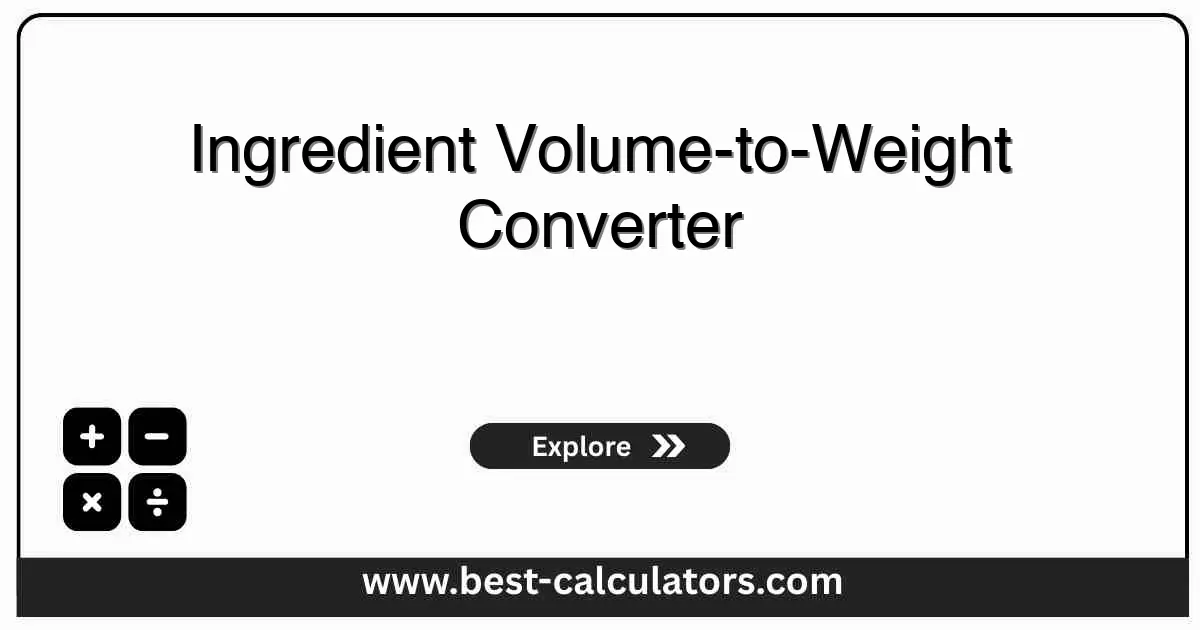Ingredient Volume-to-Weight Converter - Convert Cups to Grams, Ounces & Pounds
Free calculator to convert ingredient volumes to weights for precise cooking and baking measurements
Ingredient Volume-to-Weight Converter
Weight Results
Common Ingredient Weights (1 Cup)
Flours & Dry Goods
- All-Purpose Flour: 125g
- Bread Flour: 130g
- Cake Flour: 115g
- Whole Wheat: 135g
- Granulated Sugar: 200g
- Brown Sugar: 220g
- Powdered Sugar: 120g
Liquids & Fats
- Butter: 227g
- Vegetable Oil: 218g
- Olive Oil: 216g
- Milk: 244g
- Heavy Cream: 238g
- Honey: 340g
- Maple Syrup: 320g
Weights are approximate and can vary by brand. For maximum baking accuracy, use a digital kitchen scale.
What is an Ingredient Volume-to-Weight Converter?
An ingredient volume-to-weight converter is a free culinary tool that helps you convert between volume measurements (cups, tablespoons, teaspoons) and weight measurements (grams, ounces, pounds) for common cooking and baking ingredients. It accounts for differences in ingredient densities to ensure accurate measurements in your recipes.
This calculator helps with:
- Precise measurements - Convert volume to weight for accurate recipe scaling
- Baking accuracy - Ensure consistent results in baking where precision matters
- Recipe adaptation - Convert recipes between volume and weight measurements
- Ingredient substitution - Compare different ingredients by weight
- Professional cooking - Use weight measurements preferred by professional chefs
Related Tools: For general measurement conversions, use our Cooking Measurement Converter. For converting between salt types, try our Salt Conversion Calculator.
How Ingredient Volume-to-Weight Converter Works
The calculation uses density ratios for each ingredient:
Where:
- Density = Weight per unit volume for each ingredient
- Volume = Your input measurement (cups, tablespoons, etc.)
- Unit Conversion = Converts volume units to consistent base units
- All-Purpose Flour = ~125g per cup (reference density)
- Granulated Sugar = ~200g per cup
- Butter = ~227g per cup
Key Concepts Explained
Volume vs Weight
Volume measurements (cups, spoons) measure space occupied, while weight measurements (grams, ounces) measure actual mass. Weight is more accurate for consistent results.
Ingredient Density
Different ingredients have different densities. Flour is light and fluffy, while sugar is heavier. The converter accounts for these differences.
How to Use This Ingredient Converter
Select Ingredient
Choose your ingredient from the dropdown list
Enter Volume
Input the volume amount you want to convert
Choose Unit
Select your volume unit (cups, tablespoons, etc.)
Get Results
View the weight in grams, ounces, and pounds
Benefits of Using Weight Measurements
- • Consistent Results: Weight measurements eliminate variations in how ingredients are scooped or packed.
- • Baking Precision: Professional bakers prefer weight measurements for accuracy and consistency.
- • Recipe Scaling: Easily scale recipes up or down while maintaining proper ingredient ratios.
- • Ingredient Comparison: Compare different ingredients by weight rather than volume.
- • Professional Standards: Meet the standards used by professional chefs and bakers.
Factors That Affect Your Results
Ingredient Variations
Different brands and types of the same ingredient can have slightly different densities. The calculator uses average values for common ingredients.
Measurement Technique
How you measure volume (scooped vs. spooned, packed vs. loose) can affect results. Use consistent measuring methods for best accuracy.
Moisture Content
Ingredients like flour or sugar can absorb moisture, affecting their density. Store ingredients properly and use within recommended timeframes.

Frequently Asked Questions (FAQ)
Q: How do I convert ingredient volumes to weights?
A: Select your ingredient, enter the volume amount, choose your volume unit, and the calculator will instantly show you the equivalent weight in grams, ounces, and pounds.
Q: Why do I need to convert volume to weight in cooking?
A: Volume measurements can vary based on how ingredients are scooped or packed, while weight measurements are more precise and consistent, especially important for baking.
Q: Are the ingredient densities accurate?
A: The calculator uses standard average densities for common ingredients. Actual densities can vary slightly by brand and moisture content. For maximum accuracy, use a kitchen scale.
Q: What if my ingredient isn't listed?
A: For unlisted ingredients, use a similar ingredient's density or measure by weight directly. The calculator includes the most common baking and cooking ingredients.
Q: Should I use volume or weight measurements?
A: For maximum accuracy in baking, weight measurements are preferred. Volume measurements work well for general cooking but can be less precise.
Q: Can I convert between different weight units?
A: Yes, the calculator shows results in grams, ounces, and pounds simultaneously, so you can use whichever unit you prefer.